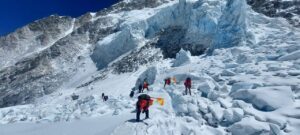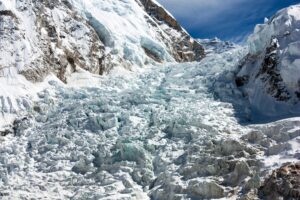Heavy snow and dangerous conditions have forced the Polish team to call off their attempt on Batura Sar, thus putting an end to a winter season with intense action but little summit glory.
This year, we’ve seen experienced winter climbers like Simone Moro, Alex Txikon and Denis Urubko in action and met some novice off-season climbers, such as Don Bowie and Lotta Hintsa, getting their feet wet on Broad Peak. Finally, the young daredevil Jost Kobusch, with his solo, alternative route up Everest. He surprised everyone by getting quite far up — and safely down. “I knew that my chances were small,” he said, “but small means that they are there, right?”

Kobusch’s high point.
Jost Kobusch
Kobusch climbed up and down the Lho La and the West Shoulder (the first part of Everest’s West Ridge) several times, establishing two higher camps. On his last outing, he reached 7,366m. He also got lost at least twice on the way down. On his latest descent, he was caught not in one — as previously reported — but two avalanches.
Still, Kobusch, who landed in Kathmandu today and declared himself “mentally still at Everest”, seemed content with his results and ready to give the route another try in future. “The repeated ascents, the changing weather conditions, my foot injury and the ongoing stomach problems — all experiences that increase my chances of reaching the summit next time,” he said. “Sometimes you have to set intermediate goals to get closer to the final goal.”
He and Urubko — who also survived an eventful final assault on Broad Peak — led the boldest, most applauded, and perhaps most reckless ascents this winter.

Alex Txikon’s Camp 2 below the snow-packed Lhotse Face. Photo: Alex Txikon
Alex Txikon
Alex Txikon opted for the more standard approach up Everest’s South Col, with a sizeable team to fix and maintain the route, especially through the Khumbu Icefall. They all worked hard but made little headway, especially when Txikon’s work-force was whittled down: Jonatan Garcia injured himself in a crevasse fall and Oscar Cardo suffered AMS, leaving Txikon with only three remaining climbing partners, all Sherpas. Eventually, he managed to bring in reinforcements — Cheppal Sherpa, who had summited Ama Dablam with Txikon one month earlier, and Furba Sherpa.
Unfortunately, the weather window forecast for the last week of February instead covered Txikon’s last hopes with a dump of fresh snow. Dangers on the Lhotse Wall changed from falling rocks to a high risk of avalanches.

Members of Txikon’s and Lakpa’s teams retreat together through the Icefall. Photo: Alex Txikon
Nepali Winter Everest
The unexpected last-minute arrival of a four-men Nepali team, led by Seven Summit Treks’ CEO Tashi Lakpa, would have lightened Txikon’s workload, since they’d only managed to fix the route up to 7,000m. But in the end, no collaboration was enough to reach the South Col without putting their safety in serious jeopardy. Lakpa’s team were not keen to progress any further either, considering that the whole point of their expedition was to summit in just five days, breaking a winter record.
Had any of the three teams stayed after February 29, they would have entered Nepal’s official spring climbing season and would have had to pay for a spring climbing permit ($11,000), even if their attempt had only taken them an extra day.

Jost Kobusch (left) and Alex Txikon compare Everest notes in Kathmandu earlier today.
Winter K2
One final bit of news: 7ST has announced that they will be attempting K2 in January 2021, in addition to their standard summer Broad Peak and K2 expeditions. Since winter K2 is also the confirmed goal of Nirmal Purja, the Russian Snow Leopards, and the Polish team just back from Batura Sar, it seems that next winter will also have lots going on.






